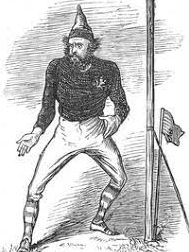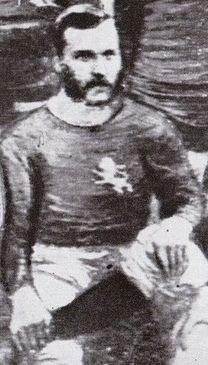Robert Gardner
Robert Gardner was a first in so many ways. He was at the age of twenty-five in the Scotland team that played in the very first international in 1872. Furthermore he was its captain, Scotland's first captain, and its organiser. Moreover, he was the game's first known tactician, in four ways. The first was team-make-up. It is generally stated that all members of the eleven were from the Queen's Park club. It is not quite correct. The Smith brothers were then turning out for South Norwood in London, although they had both been Queen's Park players and were still members. Moreover right full-back, William Ker, had been captain of rival club Granville and had been effectively co-opted. Perhaps Gardner did not fancy his own club's right back. And then there is Alex Rhind. Queen's Park own history has it that he was a 2nd-team player, promoted for perhaps one game only. He would soon return to his native Aberdeen and seemingly cease to play at all. The second was the shape of the team. The English game had a goalkeeper, a full-back, one or two half-backs and seven or eight forwards. Gardner's team took the field with two full-backs and two half-backs. Moreover they formed a box-four defence, which contracted together under attack and expanded out of defence, with Gardner in goal no doubt calling the shots. It was a system that almost immediately adopted throughout the football World, albeit that was limited to Scotland and England with Wales soon to join.


And there was the first doctoring of the pitch. Although offered a rugby ground for free he chose Hamilton Crescent, Glasgow for a fee of £20, a not inconsiderable sum then. The reason was possibly that the the rugby field was too like the large ones played on in England and Gardner seems to have wanted the much more controllable space a smaller, essentially cricket-ground offered. And the result was that a widely expected England win was turned into a 0-0 draw. And finally there was Gardner's own playing style. Initially he had played as a forward. Indeed in that first international he played part of the game up-front. But as a goalkeeper he is credited with introducing the now basic technique of advancing from the line to "narrow the angle".
It would seem Robert Gardner was a man with firm footballing ideas. Indeed depictions show him as fearsome and everything we know about his relatively short, future life points in general to him being thought and being certainly strong-minded, perhaps opinionated, possibly even difficult. He was born in 1847 in Glasgow but his family origin on both sides was Paisley. In 1861 he was already working as a clerk. In 1871, still with his parents, Robert and Janet nee Cochran, at 22 Clyde Place in Tradeston he was working as an Assistant Commercial Traveller, a salesman, and had been Queen's Park's captain for several seasons. Queen's Park had been founded in 1867. A letter of his as Queen's Park Secretary, dated 1868, is the oldest, surviving one pertaining to the game. He then married seemingly well, in Paisley in 1873 to Mary Arrol, the cousin of William Arrol, later Sir William Arrol, the renown civil engineer but son of a humble cotton-spinner. With her he was to have three sons, Robert, James and Alexander.
That same year, 1873, he again was in goal for Scotland in the second international and was one of the members of the Scottish Football Association committee on its foundation. President was Archibald Campbell of Clydesdale. However, this was perhaps a turning-point. For reasons that were never explained, whilst at the end of 1873 Gardner led the Queen's Park team that travelled to Edinburgh for a demonstration match, by the end of the 1873-74 he, and his great friend and fellow international, David Wotherspoon, a witness at his wedding, had transferred their loyalties and to Clydesdale. It meant that, whilst he remained goalkeeper in the national team against England in March 1874 and again a year later at the insistence of Queen's Park he was no longer captain. In fact he would never be national captain again.
1874 would also see Gardner lead Clydesdale to the Scottish Cup Final, losing to Queen's Park after by two latish goals, a goal for the former having been controversially disallowed after half-an-hour. The following season the two teams would meet again in the semi-final, with the latter after two replays winning by a single goal but Gardner would otherwise be quieter, except perhaps for the curious Ferguson affair.
In the first round of the 1874-5 Cup Clydesdale, now of course captained by Gardiner, objected to facing the star Vale of Leven player, John Ferguson, on the grounds that he was a "professional", having in a Scottish tradition that still exists today won prizes and prize money as an athlete. Notably in that he was probably no different to Queen's Park 's international stalwart, Joseph Taylor. The Vale then took umbrage and withdrew from the competition. Ferguson, who had been in the same, winning Scotland team as Gardner the previous year, was also dropped from the national set-up for two seasons, as was Gardner, and even when reinstated it is noticeable that the two never played in same eleven again.
Alternatively, of course, the hiatus may simply have been due to the births of Gardner's first child in 1874 and his second in 1875 taking precedent. But whatever the case in 1876 he would be back. For the first international ever to involve Wales he was referee and, after the birth of his third son in 1877, for the 1877-78 season he was elected President of the SFA and finally in March 1878 aged thirty he was back in Scotland's goal for one last time, a 7-2 victory against England, and referee once more against Wales.
Yet, with the census of 1881 it is clear there are changes. The Gardner family are living at Hillside Terrace in Dennistoun but Robert, listed as a Grain Salesman, is unemployed. It is unclear, whether this in intentional or not. William Dick of Queen's Park had been SFA Secretary until March 1880, when he was replaced by J.S. Lindsay, who part way through the season moved to London with Robert Livingstone stepping in. Dick would die the following month, aged just thirty. However, when Livingstone looked to be confirmed for the following season he was opposed, Robert Gardner is said to have stood for the paid position but he too was rejected, John McDowall, notably again of Queen's Park, being appointed and remaining in place for the next forty-six years. Gardner had to look for other work.
This he did by finding a position as a clerk once more and with William Arrol, whose company from 1882 was building the Forth Railway Bridge. And at that point his connection with football seems to have been severed. But there were problems. Gardner had or would clearly contract tuberculosis. Indeed a combination of peritonitis and consumption would take his life. In February 1887 in South Queensferry at the southern end of the bridge he would die and then simply disappear. No-one yet knows where he is buried. Meanwhile, his parents, who had earlier been relatively prosperous, had also fallen on much harder times and Gardner's sons seem to have been in part farmed out. Mary Gardner remarried in 1889, in 1891 eldest, Robert, was living with her but James and Alexander, who died aged thirteen that same year, were living in Glasgow with Gardner's elder sister and her family. And it was in the city that the two surviving boys would live out their lives, Robert not marrying and dying there in 1940 and James marrying but with no surviving children, predeceasing him in 1933.
Birth Locator:
1847 - Glasgow
Residence Locator(s):
1851 - 394, Parliamentary Rd., Glasgow
1861 - Tradeston, Glasgow
1871 -22, Clyde Place,Tradeston, Glasgow
1881 - 153, Hillside Terrace, Glasgow
Death Locator:
1887 - High St., South Queensferry, West Lothian
Grave Locator:
N/A
and
Other Sources:
Back to the SFHG Home page